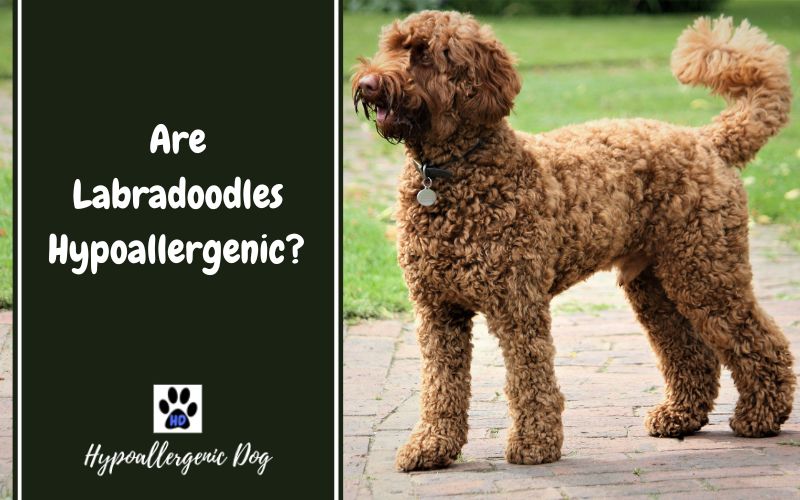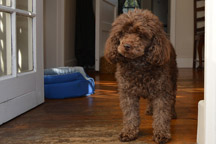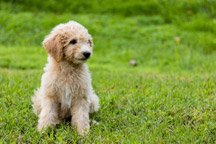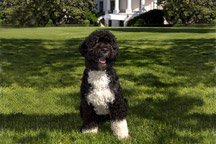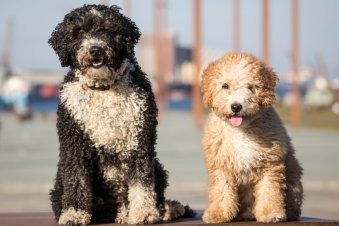Are Labradoodles Hypoallergenic?
Yes! The Labradoodle is a medium to large hypoallergenic dog breed that hardly sheds or drools.
You have probably met some pretty awesome Labradoodles, but you may be wondering if this breed is a good choice for people who suffer from dog allergies. Thankfully, these dogs are not only smart, loving, and kid friendly, but they make great dogs for those who struggle with allergies.
With the right breeding, the Labradoodles that have the Poodle coat sheds very little, has low levels of dander, and does not drool as much as some of the larger dog breeds tend to. These three factors are the hallmarks of a hypoallergenic dog breed.
For a quick summary of the Labradoodle breed features, skip to our Labradoodle dog breed summary further down the page.
Related breeds: Goldendoodle, Poodle
View more hypoallergenic dogs here.
Are Labradoodle Hypoallergenic Dogs? Contents
Labradoodle Quick Facts
About the Breed
Labradoodle Training and Exercise
Labradoodle Grooming and Care
Labradoodle Health Issues
Conclusion
Labradoodle FAQ
Labradoodle Facts Summary
Labradoodle Quick Facts
| Hypoallergenic Dog: | Yes! |
| Shedding: | Varies, depending on the genetics. |
| Drooling: | Low |
| Size: | Medium – Large |
| Breed Group: | Working (Not recognized by the AKC) |
| Lifespan: | 12-14 years |
| Energy Level: | High |
| Trainability: | High |
| Family Dog: | Yes! |

About the Breed
The Labradoodle Physical Characteristics and Coat
In case you didn’t know, the Labradoodle is a cross between two of the most popular breeds in the United States: the Labrador Retriever and the Poodle. This breed is actually fairly new and was first bred in Australia in 1988. The breed was originally bred to bring the fantastic features of the Labrador as a service dog together with the hypoallergenic coat of the Poodle, to form the first hypoallergenic guide dog. In the three decades since then, the breed’s popularity has skyrocketed both as a service dog and a family pet.
The Labradoodle’s coat is divided into three separate types: Wool is the curliest coat type and is most similar to the classic curls of the Poodle. Fleece is less curly but is still has a fairly wavy texture. Hair is the last type, which is most similar to the coat of the Labrador and can be anywhere from straight to curly.
Just a quick recommendation for all those looking to get a Labradoodle. We suggest 112 Dog Hacks. This book is loaded with awesome quick tips – like how to fix a bad behavior, what to feed your dog, and so on and so forth. Better still, it comes with a money back gaurauntee if you feel jipped! Click here for more info.
Some Labradoodles are most definitely hypoallergenic, and others are not. If you have dog allergies and need to ensure your new Labrador-Poodle mix is hypoallergenic, choose a reputable breeder, and a litter of puppies where both parents are second generation Labradoodle and have the Poodle non-shedding coat. Labradoodles with wool coats tend to have the best hypoallergenic qualities.
This large dog breed comes in a wide variety of colors including black, white, brown, golden, and more! They even come in multi-colored varieties. Where size is concerned, this breed is considered to be a large dog, growing on average up to about 25 inches and weighing up to 65 pounds. This breed usually lives to be between 12 to 14 years old.
There are a lot of excellent qualities of the Labradoodle, aside from their fluffy anti-allergy coat.

Labradoodle Temperament
Firstly, these dogs are fantastic pets for families with children. Their affectionate personalities and playful spirits make them a wonderful animal for kids to grow up with. Additionally, their large, sturdy build holds up well to rough play.
This breed features a generally fantastic temperament, whether they are used as guide dogs or simply as companion animals. They are playful, silly, and tend not to bark much. These pups are so loveably cute that they will quickly convert any cat person into a dog lover!
Due to it’s amiable, people pleasing nature, the hypoallergenic Labradoodle is great for those who have not owned a dog before!
Labradoodle Training and Exercise
Encouraging Good Behavior In Your Labradoodle
(Skip this section)
While it can’t be denied that the Labradoodle makes a fantastic pet for singles, couples, and families, there are a couple of aspects of this breed that should be taken into consideration prior to bringing a Labradoodle into your home.
These dogs are extremely energetic and require at least an hour of exercise every day in order to remain happy and healthy.
They are intelligent and easy to train, whether for hunting or just for general tricks, so they need plenty of mental stimulation to avoid boredom. Luckily, Labradoodles are very people pleasing in addition to being smart, so they pick up on house training quickly.
Unfortunately for those who are not homeowners, Labradoodles do not make great apartment dogs.
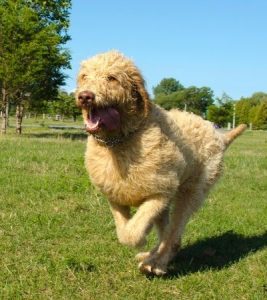
Exercise Needs
Labradoodles require extensive exercise to maintain obedience and discipline. If this breed is not provided with enough exercise daily, or is left alone for long stretches of time, they can often become bored which usually leads to destructive behavior. Do not be surprised if your carpet, furniture, or even your lawn takes a beating from an under exercised Labradoodle.
Labradoodles are also well suited to many dog sports. Participating in some of these sports, such as agility training, is fun, great exercise, and mentally stimulating for your dog. Additionally, it’s great for socialisation with other dogs and their humans for your friendly companion!
Too busy to exercise your Labradoodle?
These dogs can be intense, but luckily, there’s other was to tucker them out instead of constantly running around. Rainy days and blizzards are a great time to bust out brain training for dogs. This awesome package is loaded with great tips to make your dog smarter, less destructive, and super cool. All for a price way cheaper than what you’re thinking! Check it out here.
Labradoodle Grooming and Care
Maintaining Your Labradoodle’s Coat
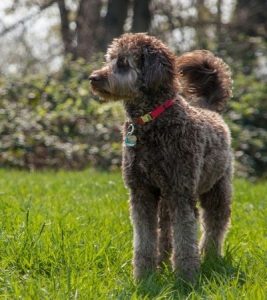
(Skip this section)
Labradoodles do not need to be bathed often, and their coat is typically low odor. While they may need to be brushed, the amount of grooming necessary for a Labradoodle varies depending on its coat type. Labradoodles with prominant Poodle coats will need to be clipped roughly every 6 weeks.
Teeth, Ears and Nails
Like all dogs, this large breed requires nail trimming about once a month and they should have their teeth brushed every 2-3 days. Due to their floppy ears, it’s important to check up on their ears often. Floppy ears are more prone to developing bacteria and yeast infections. Clean their ears once a week and check for odor or discoloration.
Health
Labradoodle Health Issues and Care
Finally, while the Labradoodle is a fairly healthy breed, there are a couple of health concerns that are common in this non-shedding dog. Due to genetics, Labradoodles may develop hip dysplasia, a condition that results from the malformation of the hip joint. Often times, dogs with hip dysplasia have a hard time climbing stairs or standing up after having laid down. This can pose a problem for owners that aren’t strong enough to lift or assist a full grown Labradoodle with this disorder. One of the leading causes of hip dysplasia in dogs is excessive weight, and as Labradoodles love to eat, it is important to maintain a disciplined, healthy weight for this breed at all times.
In addition to hip dysplasia, Labradoodles can often develop genetic problems with their eyes, including cataracts and progressive retinal atrophy. Both of these conditions can advance to complete blindness. To avoid these genetic health concerns, it is important to find a breeder who is dedicated to preserving the health of the breed. Make sure to obtain genetic information on your pup’s lineage to ensure there are no health problems with the line, and always take care to give your dog proper veterinary treatment.
Labradoodles may be an expensive investment, but if the price point seems high, dedicated Labradoodle rescue facilities are available. Always remember that rescued dogs may have some behavioral or health problems due to poor handling from their previous owners, or from having been purchased from an irreputable breeder or puppy mill. Be sure to thoroughly communicate your situation and expectations with a rescue volunteer in order to find a rescue dog that suits your life well.
Conclusion
(Skip this section)
As more and more people are finding that they are allergic to dog fur, dander, and saliva, there are more and more breeds popping up as ‘hypoallergenic’. Some hypoallergenic breeds are better than others for those with allergies and it can often be difficult to determine which breed is truly best for you and your family. If you are concerned about allergies and are considering a Labradoodle, discuss your allergies with a reputable Labradoodle breeder, and visit the parents in person. A loving, jolly, friendly pooch – the intelligent Labradoodle is an excellent allergy friendly addition to the family!
Labradoodle FAQ
Do Labradoodles Shed a Lot?
Being a mix between Labradors and Poodles, Labradoodles may shed or they may not. This can be somewhat unpredicatble. To ensure you find a hypoallergenic Labradoodle that doesn’t shed much, be sure to choose a Labradoodle puppy, whose parents are both second generation Labradoodles and have non-shedding coats like a Poodle.
Do Labradoodles Smell?
Labradoodles who are fed a healthy diet and groomed and bathed when needed tend to have low odor.
Are Labradoodles Smart?
Yes! Being the product of two highly intelligent dog breeds – a Labrador and Poodle cross – makes the Labradoodle very smart.
Are Labradoodles Good Family Dogs?
Yes! Labradoodles make brilliant family dogs! They are affectionate, great with kids, and patient.
Labradoodle Facts Summary
| Breed | Labradoodle |
| Other Names? | Australian Labradoodle, American Labradoodle, Labrapoodle, Labrador Poodle Mix, Labradordoodle, Labradorpoo, Labrapoo, Standard Labradoodle, |
| Hypoallergenic? | Yes |
| Height | Male: 22 to 24 inches or 55 to 60.96 cm Female: 21 to 23 inches or 53.34 to 58.42 cm |
| Weight | 50 to 65 pounds or 22.67 to 29.48 kg |
| Lifespan | 12 to 14 years |
| Temperament | Smart, silly, laid back, quiet, calm, intelligent, and bright |
| Colours | Gold, apricot, café, caramel, cream, chalk, parchment, black, chocolate, red, silver, and blue. They can also have parti-colored coats, including phantom, patched, brindles, or sable colors. |
| Coat – describe the coat | The Labradoodle’s coat is divided into three separate types: Wool is the curliest coat type and is most similar to the classic curls of the Poodle. Fleece is less curly but is still has a fairly wavy texture. Hair is the last type, which is most similar to the coat of the Labrador and can be anywhere from straight to curly. |
| How much grooming? | Needs one or two brushings per week, as well as regular grooming that includes ear cleaning and nail clipping. |
| How much shedding | Low-to-no shedding |
| Dander levels | Low dander level |
| Saliva – Do they Drool or Lick much? | Low |
| Energy levels | High-energy dog |
| How much exercise do they need? | 40 mins to 1 hr of exercise daily |
| Health problems | Prone to hip and elbow dysplasia, an eye disease called progressive retinal atrophy, and von Willebrand’s disease |
| Good for apartment? | Apartments are not the ideal setting for this energetic dog. |
| Suitable for kids? | Great with children |
| How much do they bark? | Low tendency to bark. Not an ideal guard dog. |
| Can they be left alone? | Not the best dog to leave alone for long periods. They may suffer separation anxiety. |
| Intelligent? | Highly intelligent |
| Trainable? | Easy to train |
| How popular as a pet? | Popular |
| Any other important facts? | This designer breed was originally developed “down under” by the Royal Guide Dogs Association of Australia. The first crosses between Labs and Poodles were an attempt to produce hypoallergenic guide dogs. The successful result was smart and sociable dogs with both an appropriate nature for guide dogs and a low-shedding coat. |

